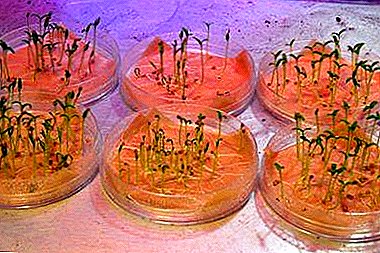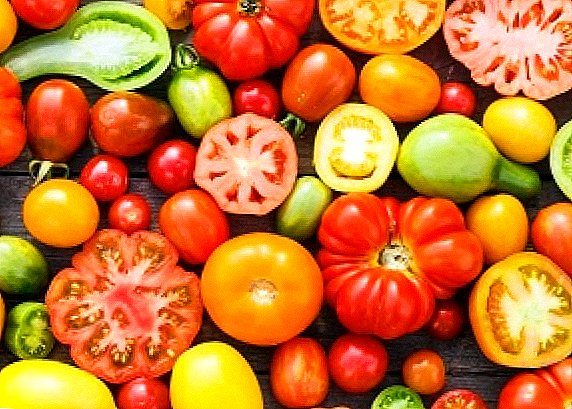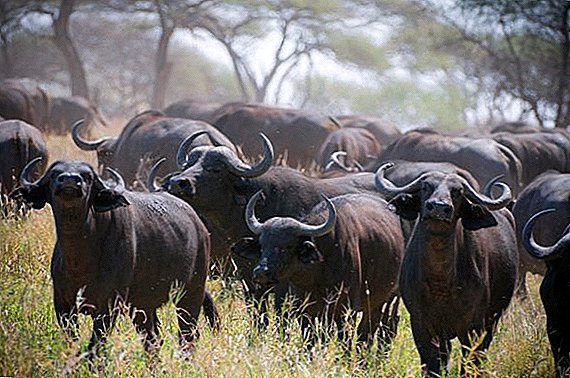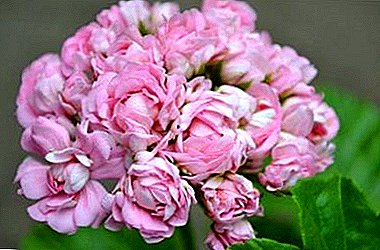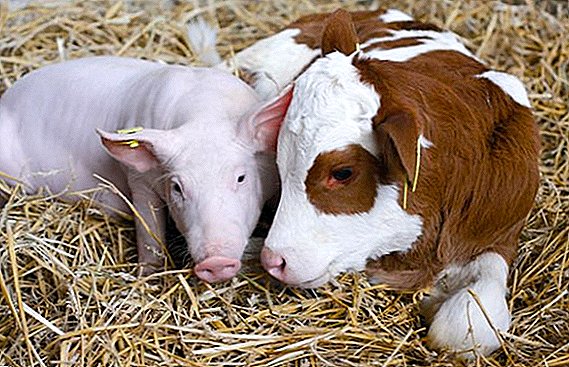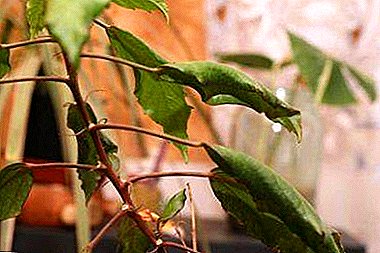 The extraordinarily beautiful plumage, endurance and long-flight of birds of this breed cannot but cause admiration not only among pigeon breeders, but also among beauty lovers in all its manifestations. Volsky pigeons deserve to know more about them.
The extraordinarily beautiful plumage, endurance and long-flight of birds of this breed cannot but cause admiration not only among pigeon breeders, but also among beauty lovers in all its manifestations. Volsky pigeons deserve to know more about them.
History reference
As a separate breed, these pigeons have been known since the end of the 19th century. They were withdrawn in the Russian city of Volsk, which gave them a name. For these high-flying pigeons such breeds were used as:
- grivchiki;
- Oak blue or blue;
- Kamyshin.

Appearance and physique
As well as representatives of any other breed, Volsky pigeons have their own characteristics:
- color can be represented in gray, black, blue, red, yellow shades;
- body length - 35-40 cm;
- wings - long, almost touching the ground, dropped below the tail;
- tail - 15-22 cm in length, flat, raised at an angle of 35-40 degrees, consists of 16 wide steering feathers;
- head - the shape is oblong, smooth, rounded;
- eyes - medium size, dark;
- beak - medium length, light beige, straight;
- cemetery - light, small size, powdered;
- neck - medium height and fullness, dense;
- paws - short, densely feathered, cosm length - 3-6 cm.

Flight performance
This breed is valued for its flight qualities, which include:
- long flight duration (about 6-7 hours) - such loads assume the strength and endurance of the pigeon;
- excellent orientation in space and terrain;
- ability to fly in circles;
- the ability to perform figures "aerobatics" (tumbling);
- flight both high and low;
- excellent memory - even if the pigeon flew too far (up to 10 km), he remembers his place of residence and will always return home.
Consider the most popular breeds of flight pigeons: Iranian, Roman giant, German show, Hungarian, hryvnia and kasan.
Conditions of detention
The remarkable qualities of the birds of this breed include simple conditions for their keeping. 
Dovecote
First of all, pigeons need a "house" - dovecote. The main conditions for comfortable living of birds should be the following:
- recommended height: about 2 m (can be slightly lower and slightly higher);
- door size: height - 1.5 m, width - 50-60 cm;
- window size: their area should be a tenth of the floor area, they should be placed on the south or south-east side;
- size of years (it is better to have two): height - 15-25 cm, width - 10-25 cm.
Certain conditions are necessary for breeding and growing pigeons. Read more tips and tricks for building a dovecote.
For convenience, it is necessary to divide the dovecot into several sections:
- one thing - for young pigeons;
- two - for separation of females and males in the winter;
- one thing - for storage of feed and household appliances.
 In winter, the temperature in the dovecote should not fall below + 4-7 ° С, in the summer - do not rise above +20 ° С.
In winter, the temperature in the dovecote should not fall below + 4-7 ° С, in the summer - do not rise above +20 ° С.Familiarize yourself with all the features of keeping domestic pigeons, as well as read about keeping pigeons in the winter.
The room should be well ventilated, but without drafts. To do this, you need to make one hole (supply) at a height of 10-15 cm from the floor, cover it with a grill. Place the second (exhaust) above the first (on the wall or on the ceiling) and also cover it with a grid. In winter, both holes tightly closed.
To avoid drafts, the windows should not be placed on opposite walls of the dovecot.
Perches
It is necessary to provide a separate place for each pigeon. This is especially important for the maintenance of Volsky pigeons, the wings of which are very lowered will get dirty, which may cause the plumage to deteriorate. Perches are made of bars. Their width should be 2-5 cm.  They are suspended at a height of 25-45 cm from the ceiling. In addition to the bars of the rails made bumpers that are attached to the wall. Reiki thickness should be 2-3 cm.
They are suspended at a height of 25-45 cm from the ceiling. In addition to the bars of the rails made bumpers that are attached to the wall. Reiki thickness should be 2-3 cm.
Nest
For breeding offspring should provide special shelves with nests. The recommended width of the boards is 30-40 cm, length - 70-85 cm. For the same purpose it is possible to make boxes of the indicated sizes. They are set on top of each other in tiers. There may be several such tiers.
Agree, one of the main conditions for competent breeding pigeons is the arrangement of their nests.
Manger
The most practical and popular options for feeders - wooden or plastic. Both options can be purchased at pet stores, and you can do it yourself. In order for the feeder to perform its basic functions, it is necessary to observe several simple conditions:
- the feeder must be closed to exclude the scattering of grains and the ingress of debris, rain or snow into it;
- a pallet is needed - so that the food does not spill on the floor or on the ground;
- pigeons should have open access to feed, but so as not to get into his paws;
- the feeder should be easy to use and maintain;
- approximate dimensions: length - 70 cm, width - 25 cm, depth - 8 cm.

Drinking bowl
The drinking bowl can either be separate or part of the feeder. You can make it from a plastic bottle, galvanized iron.
Important! The main condition is the depth of the drinker - it must be at least 8 cm.
If it is shallow, pigeons will swim in it, and not drink water. Depth is also important for the reason that when you drink a bird, you immerse your head in water rather deeply - right up to your eyes. The length and width of the drinker are arbitrary.
You can not leave young pigeons without attention - from overheating or from not knowing the place of drinking trough, they may simply die. Therefore, you should take into the hands of such a pigeon and bring it to the place for drinking. 
Litter
The litter can be from different materials that combine some requirements. She must be:
- durable;
- dense;
- warm
- moisture-proof (do not pass or absorb moisture);
- easy to clean and wash;
- Requires a slope to the outer wall for dripping moisture.
Did you know? Pigeon-carrying pigeons during the Second World War suffered about 15 thousand messages, and only 2% of them were not delivered to the recipients.
There are several options for flooring in dovecote:
- Pieces of linoleum that are laid on plywood. They are easy to clean, they do not get under the moisture, they are flexible and flexible even in the coldest time of the year, do not require sprinkling with sawdust or sand.
- Concrete, which is sprinkled with sawdust on top and covered with a grid. The droppings fall through it, and the pigeons remain clean. For cleaning, it is enough to lift the grate and scoop up sawdust.
- Sand or its mixture with ash is a very convenient way of arranging the floor in the dovecote, when using a fan-like rake it is enough to scrape lumps of litter. But this is also the most expensive way - a layer of sand should be at least 5 cm and should be poured all the time.

Pigeon house cleaning and disinfection
The current cleaning of the pigeon house should be carried out daily, more thorough - regularly every 5-7 days.
- For cleaning must be special devices. (small blades, planted on long sticks), because it is held by hand.
- The first thing removed litter, which is a source of infection and disease of pets, since it carries eggs from pathogens of intestinal diseases, salmonella and coccidiosis. Especially it is worth paying attention to the hygiene of the nests, in which there are 2-4-week-old chicks. Toddlers emit a lot of litter, so it is advisable to put paper, newspapers, burlap or sawdust under the nests, which need to be replaced as needed.
- The trough must be cleaned regularly of dust and debris that has entered it, feed also requires daily replacement.
- In the hot season, the drinking bowl should be rinsed with water, washed daily. It is also worth ensuring that it always has fresh water. Once a week it is worth thoroughly washing and rinsing the feeders and drinkers with boiling water diluted with soda (1 tbsp. Per bucket of water).
- General cleaning in the dovecote is carried out 2 times a year. It is better to do this in the off season - in the fall or spring. At this time, all components of the pigeon house are thoroughly washed out, feeders and drinkers are taken out of it. For washing, you can use the "Whiteness" or "Domestos". The walls are covered with a broom, the floor is washed away. Inside is whitewashed lime. It takes about 2-3 hours to dry the room. Pigeons at this time removed from their "house".
 As for disinfection, in order to prevent it is carried out every two weeks. The only exception is situations when it is necessary to extinguish or prevent an outbreak of an infectious disease - then these activities are carried out outside the usual schedule. Disinfection includes 2 stages:
As for disinfection, in order to prevent it is carried out every two weeks. The only exception is situations when it is necessary to extinguish or prevent an outbreak of an infectious disease - then these activities are carried out outside the usual schedule. Disinfection includes 2 stages:- wet
- aerosol.
Important! Nests and perches should be located so that the pigeons do not soil each other.
The first stage involves the treatment of the premises with disinfectants, which are diluted in hot water. Formalin, caustic soda and chloramine are most commonly used for this purpose.
At the second stage, aerosol treatment is used. A disinfectant mixture is placed in an enamel bowl, filled with hot water. Steam, formed as a result of a chemical reaction, penetrates to all corners of the pigeon house and, acting for an hour, disinfects it. For the preparation of the mixture most often used:
- formalin - 45 g;
- potassium permanganate - 30 g;
- water - 20 g
 Birds at the time of sanitary measures are removed from the premises. After disinfection, the dovecote is ventilated for an hour. After that, the admission of birds is possible.
Birds at the time of sanitary measures are removed from the premises. After disinfection, the dovecote is ventilated for an hour. After that, the admission of birds is possible.However, you can disinfect the pets themselves. Of the most simple preventive measures - bathing, which is held every week. 1 ml of formalin is added to water (per 10 l).
Did you know? Pigeons are very faithful and loyal partners - they choose a couple once and for a lifetime.
Bathing bath size:
- length - 90-100 cm;
- width - 60-70 cm;
- depth - 20 cm.

What to feed
The basis of the diet of pigeons is grain:
- wheat;
- corn;
- barley;
- millet;
- millet;
- chopped peas, beans, lentils, beans;
- sunflower seeds.
For the full growth of pigeons need a proper, balanced diet. Read about feeding domestic pigeons.
In the pet menu, except for grain, you can also include:
- boiled potatoes;
- boiled pumpkin;
- grated or boiled carrots;
- cabbage.
 As the simplest vitamin supplements give:
As the simplest vitamin supplements give:- sorrel;
- clover;
- nettles;
- cabbage;
- alfalfa;
- rape;
- spinach;
- young green grass.
Important! For flight breeds, pigeons should be located at a height of 1-1.5 m.
Do not do without minerals:
- eggshell;
- crushed shell rock;
- ground charcoal;
- crushed red brick chips;
- salt (20 mg per 1 liter of water).
 The frequency of feeding depends on the seasons. In summer, the food is more intensive; feed is given to birds 3 times a day. And evening feeding is a must. In winter they feed twice in the morning (8-9 hours) and in the evening (19-20 hours). Pigeons feeding the chicks receive increased nutrition. The first feeding is carried out at 4-5 in the morning, the second - at 12-13, the evening - at 20-21 hours.
The frequency of feeding depends on the seasons. In summer, the food is more intensive; feed is given to birds 3 times a day. And evening feeding is a must. In winter they feed twice in the morning (8-9 hours) and in the evening (19-20 hours). Pigeons feeding the chicks receive increased nutrition. The first feeding is carried out at 4-5 in the morning, the second - at 12-13, the evening - at 20-21 hours.There is a list of products that should not be given to pets:
- rye;
- bread (especially black);
- meat and meat products;
- milk;
- a fish;
- cheese;
- sweets (candy, marmalade, chocolate);
- butter;
- all products from the human table.
Acceptable and Invalid Defects
Before you get pets, you need to familiarize yourself with the features of the breed, to know its distinctive features, so as not to get a pigeon "surrogate." The permissible disadvantages of the pigeons are:
- lack of "shaggy" paws;
- slight mismatch of plumage pattern;
- a darker beak than described in the breed standard;
- insufficient length tail feathers and wings.
 Invalid are:
Invalid are:- drawing and color of feathering that do not meet the standard;
- very dark beak:
- feathers and tail feathers too short;
- the tips of the wings that do not touch the ground at all.



